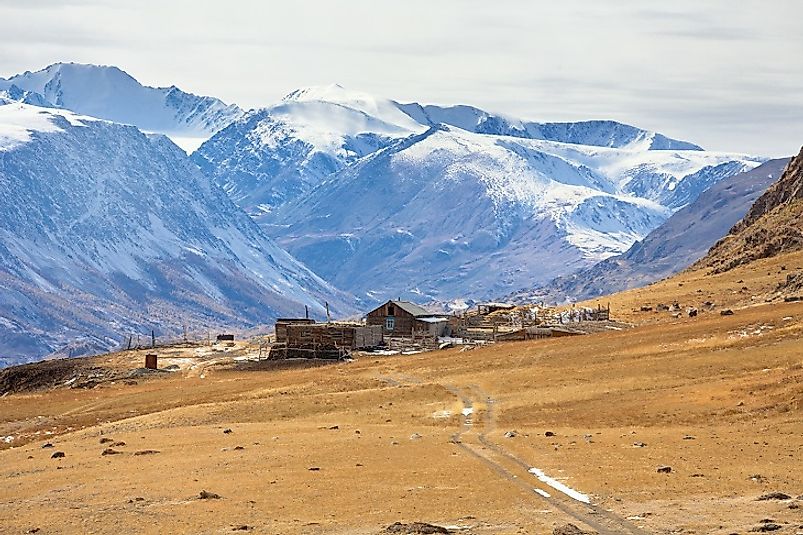What Is The Rain Shadow Effect?

5. Description
Often times, mountains stand as barriers to clouds so as to prevent precipitation from falling on certain sides of them. This phenomenon is the result of the warm moist air that rises accompanied by prevailing winds at the tops of mountains. The warm air mass is pushed upwards to higher altitudes to produce rain or showers, and when it passes over a mountain it cools down. As it hurdles the top of a mountain, it quickly dries up and goes down the other side of a mountain, gaining back its warm mass which sucks up moisture as it travels downwards. As a result of the removal of moisture, the area becomes a dry region devoid of further precipitation by the action of the warm, moist air.
4. The Interplay of Climate and Terrain
When high terrain and climate interact, a rain shadow always seems to affect a region. The earth has regular movements of "prevailing winds" that go around the equator. These winds are called the "trade winds", and are located at 30° North and 30° South latitudes. The trade winds which are present in the Northern Hemisphere come from the northeast, and those in the Southern Hemisphere come from the southeast. The "Westerly winds" are located 30 and 60 degrees latitudes, and, in contrast to the trade winds, originate from the southwest in the Northern Hemisphere and originate from the northwest in the Southern Hemisphere. All of these prevailing winds help generate the rain shadow effect that is commonly found around the world.
3. Examples of Rain Shadow Areas
In Asia, the Himalaya mountain range acts as the catalyst for the rain shadow effect over the Tibetan Plateau, Central Asia, and the Gobi Desert. The Japanese Alps create that same phenomenon over the Kanto Plain in the Tokyo region. The Arakan Mountains also have that effect over the central regions of Myanmar. In the Middle East, the Judean Hills have the same effect on the Dead Sea and the Judean Desert. The Zagros and Elburz Mountains in Iran create the same effect over the Dashti-Lut region. In South America, the Atacama Desert, Mendoza region, and Valle Central in Chile, the experiencing of a rain shadow effect therein is due to the presences of the Andes Mountains. The Sierra Nevada de San Marta creates the same effect on the Guajira Peninsula in Colombia. In the United States of America, Utah and Nevada have a rain shadow effect due to the Cascade Mountains of Oregon. The Santa Cruz Mountains also have that effect over the San Jose region of California. In Europe, many mountains have that effect on many areas as well.
2. Ecological Significance
Rain shadows affect the patterns of much needed rain and moisture in mountains, that in turn replenish and encourage growth to new forests and old growth forests situated in its biome. This occurs as warm moist air is lifted upwards the sides of a mountain by prevailing winds that bring rain to mountains. Water from rain sustains every form of life present on mountains. Although only the windward side of a mountain gets the bulk of the moisture, while the leeward side remains dry, many desert plants that have commercial value would cease to exist if they received more precipitation than they require. Snow caps almost always cover the top of high altitude mountain peaks, and also bring some relief to the leeward side of that mountain when they partially melt.
1. Role in Agriculture, Commerce, and Water Supply
One of the most most important aspects of rain shadows is that they differentiate moist and arid regions. Desert dust particles that are swept up into the global atmosphere offer some significant minerals to oceanic phytoplankton that need the phosphorus and silicon they contain to grow. The Amazon Basin in particular benefits from the desert dust that comes from as far away as the Sahara Desert and carried over the oceans. Certain kinds of soda, boron, and nitrates are exclusively found in the deserts, and have commercial value. Deserts' mild nighttime temperatures act as catalysts for aquaculture. Micro-algae and biologically-derived chemicals are better manufactured in the year-round solar radiation environment of the deserts. Water supply is greatly affected by rain shadows, and, for an example, the Atacama Desert has some areas which have not seen rain for 400 years. On the other hand, the windward side of a mountain benefits from the rain shadow by receiving increased precipitation.











